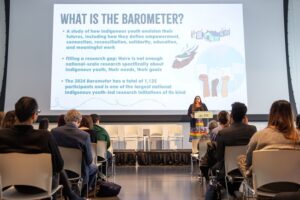Indigenous Youth Roots release report following nationwide survey

By Sam Laskaris
OTTAWA – Indigenous youth across Canada have a drastically different opinion about reconciliation than they did five years ago.
That’s according to the results of a nationwide survey that has been released.
Indigenous Youth Roots (IYR) gathered data from a total of 1,125 First Nations, Inuit, and Métis youth aged 18-29 from across the country. The 2024 survey was considered the largest Indigenous youth-led research initiative in Canada.
Upon compiling results, the IYR, a national non-profit and registered charity, released a report in mid-February titled, Indigenous Youth Reconciliation Barometer: Building Connected Futures.
The IYR had conducted its first national survey in 2019; however, that one included both Indigenous and non-Indigenous participants, partly to get opinions of both about their thoughts on reconciliation.
Megan Lewis, the IYR’s director of the Centre for Indigenous Policy and Research, said there was one item that stuck out to her from this year’s report when compared to the one five years earlier.
“What was kind of interesting to us is quite a significant amount of Indigenous youth said that reconciliation was important to them – 85 per cent,” said Lewis, who is based in IYR’s Ottawa office. “And that it was an important step in healing and ensuring that Indigenous people were treated equitably.”
Lewis was surprised, however, with another stat.
“Back in 2019, if we’re comparing a little bit of the information, the 2019 barometer we had three-quarters of those folks believed or had somewhat of an optimistic belief that reconciliation was possible,” she said.
But the results from the latest survey showed a stark drop, where only about 50 per cent believed it was possible.
“When we look at what we heard from youth, it demonstrated that they’re believing less and less in the system, like government,” she said. “That was particularly one of the ones that they felt were less committed to reconciliation at all levels. And they’re leaning so much more on their communities to advance those futures that they’re so dedicated to.”
The IYR gathered its information via in-person, online sharing circles, as well as an online survey.
Participants from all 10 provinces and three territories took part in the survey.
“We had the most participation from youth in Ontario, but we didn’t filter by from which specific communities they were from,” Lewis said.
Ontario had 363 respondents while Alberta had the second most with 178 participants.
“We got participation from everywhere but there were some of course that were lower,” Lewis said. “But I would say it was a relatively good representation based on how many folks live in those provinces and territories. So obviously we had lower participation from P.E.I. for example.”
IYR officials identified four key themes in their report. They were:
- personal and community empowerment
- culture, language, and wellness
- education and meaningful work
- reconciliation and solidarity
The 194-page report also includes recommendations for each theme.
“We did some broad recommendations in the report, something that we feel is often missing from large-scale research is those next steps or where do we go from here,” Lewis said.
She believes it was vital to include these recommendations.
“For us, we have a lot of responsibility to the youth that we engaged with,” she said of those who provided their time and energy and their stories of what they’re going through in their communities. “So, for us it wasn’t just about putting together a report that would share data and numbers.”
Lewis added the IYR will advocate alongside Indigenous youth to push forward these recommendations.
Lewis also said that not all of the data that was compiled was released in the report. For example, the ages of the participants, their sexual identity, and whether they live on or off-reserve was not shared.
That information though might be made available.
“We want it to be really accessible,” Lewis said. “We’re going to be looking to release an interactive dashboard over the next year, which is going to allow for communities and also governments and anyone who wants to engage in this data in a way that will help serve community and what they are interested in.”

